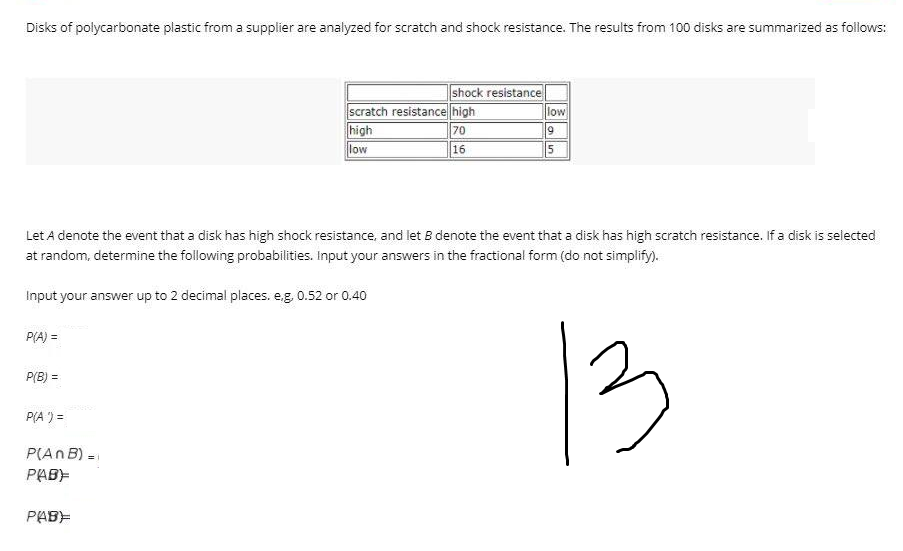Disks of polycarbonate plastic from a supplier are analyzed for scratch and shock resistance. The results from 100 disks are summarized as follows: shock resistance scratch resistance high high low low 70 19 16 5 Let A denote the event that a disk has high shock resistance, and let B denote the event that a disk has high scratch resistance. If a disk is selected at random, determine the following probabilities. Input your answers in the fractional form (do not simplify). Input your answer up to 2 decimal places. e,g. 0.52 or 0.40 13 P(A) = P(B) = P(A ') = P(An B) = PABE PABE
Disks of polycarbonate plastic from a supplier are analyzed for scratch and shock resistance. The results from 100 disks are summarized as follows: shock resistance scratch resistance high high low low 70 19 16 5 Let A denote the event that a disk has high shock resistance, and let B denote the event that a disk has high scratch resistance. If a disk is selected at random, determine the following probabilities. Input your answers in the fractional form (do not simplify). Input your answer up to 2 decimal places. e,g. 0.52 or 0.40 13 P(A) = P(B) = P(A ') = P(An B) = PABE PABE
Chapter8: Sequences, Series,and Probability
Section8.7: Probability
Problem 4ECP: Show that the probability of drawing a club at random from a standard deck of 52 playing cards is...
Related questions
Question

Transcribed Image Text:Disks of polycarbonate plastic from a supplier are analyzed for scratch and shock resistance. The results from 100 disks are summarized as follows:
shock resistance
scratch resistance high
high
low
low
70
19
16
5
Let A denote the event that a disk has high shock resistance, and let B denote the event that a disk has high scratch resistance. If a disk is selected
at random, determine the following probabilities. Input your answers in the fractional form (do not simplify).
Input your answer up to 2 decimal places. e,g. 0.52 or 0.40
13
P(A) =
P(B) =
P(A ') =
P(An B) =
PABE
PABE
Expert Solution
This question has been solved!
Explore an expertly crafted, step-by-step solution for a thorough understanding of key concepts.
This is a popular solution!
Trending now
This is a popular solution!
Step by step
Solved in 2 steps with 2 images

Recommended textbooks for you

